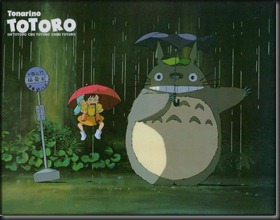
Japanese director Hayao Miyazaki and Mexican director Guillermo del Toro both represent fantasists of the first order: their films blend science fiction, fantasy, horror, fairy tales, and children’s stories together with distinctively original visual aesthetics to create some of the most magical cinema of the last thirty years.
Miyazaki holds a special place in my heart because I first discovered him as a child back in the 1980s when a strange science fiction cartoon appeared on HBO called Warriors of the Wind. I was thoroughly entranced
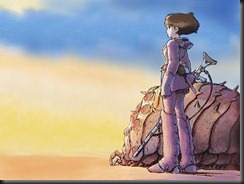 by the tale of a post-apocalyptic world in which one valley manages to stay green amidst the radioactive deserts that teem with gigantic, mutated bugs. This one valley represents an idyllic utopia powered by windmills where the people live in harmony and carry on with a green existence in the face of global death. Soon, greedy militarists attack and colonize the valley with their massive airships in a quest to revise one of the fire gods who destroyed the world during the “Seven Days of Fire.” Even as a child, the film’s message about environmentalism, which was not quite en vogue yet in the 80s, was plain as day and the film left me with a lasting impression about the evils that humankind—particularly the elite and the powerful power—can perpetrate against our environment. Of course, what most enchanted me as a child was the film’s amazing science fiction visuals that were unlike anything seen in the cinema to which I was accustomed. Plus, the cartoon featured violence and bloodshed that I was not accustomed to seeing in animated form. Its mix of action, fantastic visuals, and a storyline that still breaks my heart to this day left an indelible impression on me and no doubt inaugurated my love of anime even before I knew such a genre existed. Fast-forward ten or twelve years into the late 90s, and I was finally able to track down this film. Except for those few showings on HBO, my Beta videocassette copy of the film was the only proof I had that the film even existed—if you don’t know what Beta is, go ask your parents. Thanks to this new thing known as the Internet, I was able to find Warriors of the Wind, which I discovered was actually a severely cut and bastardized version of a Japanese film called Nausicaa of the Valley of the Wind (1984).
by the tale of a post-apocalyptic world in which one valley manages to stay green amidst the radioactive deserts that teem with gigantic, mutated bugs. This one valley represents an idyllic utopia powered by windmills where the people live in harmony and carry on with a green existence in the face of global death. Soon, greedy militarists attack and colonize the valley with their massive airships in a quest to revise one of the fire gods who destroyed the world during the “Seven Days of Fire.” Even as a child, the film’s message about environmentalism, which was not quite en vogue yet in the 80s, was plain as day and the film left me with a lasting impression about the evils that humankind—particularly the elite and the powerful power—can perpetrate against our environment. Of course, what most enchanted me as a child was the film’s amazing science fiction visuals that were unlike anything seen in the cinema to which I was accustomed. Plus, the cartoon featured violence and bloodshed that I was not accustomed to seeing in animated form. Its mix of action, fantastic visuals, and a storyline that still breaks my heart to this day left an indelible impression on me and no doubt inaugurated my love of anime even before I knew such a genre existed. Fast-forward ten or twelve years into the late 90s, and I was finally able to track down this film. Except for those few showings on HBO, my Beta videocassette copy of the film was the only proof I had that the film even existed—if you don’t know what Beta is, go ask your parents. Thanks to this new thing known as the Internet, I was able to find Warriors of the Wind, which I discovered was actually a severely cut and bastardized version of a Japanese film called Nausicaa of the Valley of the Wind (1984).  For those interested in such things, Nausicaa is the princess who gives Odysseus sanctuary in The Odyssey when he washes up half-dead on a foreign shore—it’s also the chapter of James Joyce’s Ulysses in which Leopold Bloom masturbates on a Dublin beach while watching girls sunbathing. I further learned that the film was directed by Hayao Miyazaki, the same director who created a certain children’s film that my kid sister was in love with at the time: My Neighbor Totoro (1988). As I watched Totoro with my little sister, I discovered a film made on the level of children that watch Nick Jr. shows but a film filled with more magic and a deeper understanding of childhood innocence and tragedy than the entire Disney canon combined. Totoro is afilm that regresses you to childhood by reigniting the sense of wonder and beauty that can only be experienced by the innocent, but it also is a film, like Spirited Away, about the child-mind’s method of dealing with tragedy and darkness. Like the bulk of Miyazaki’s films, it is song of both innocence and experience, to use a somewhat tired Blakean metaphor.
For those interested in such things, Nausicaa is the princess who gives Odysseus sanctuary in The Odyssey when he washes up half-dead on a foreign shore—it’s also the chapter of James Joyce’s Ulysses in which Leopold Bloom masturbates on a Dublin beach while watching girls sunbathing. I further learned that the film was directed by Hayao Miyazaki, the same director who created a certain children’s film that my kid sister was in love with at the time: My Neighbor Totoro (1988). As I watched Totoro with my little sister, I discovered a film made on the level of children that watch Nick Jr. shows but a film filled with more magic and a deeper understanding of childhood innocence and tragedy than the entire Disney canon combined. Totoro is afilm that regresses you to childhood by reigniting the sense of wonder and beauty that can only be experienced by the innocent, but it also is a film, like Spirited Away, about the child-mind’s method of dealing with tragedy and darkness. Like the bulk of Miyazaki’s films, it is song of both innocence and experience, to use a somewhat tired Blakean metaphor. Miyazaki’s first feature-lgenth film was part of the Lupin III series of television shows and films entitled The Castle of
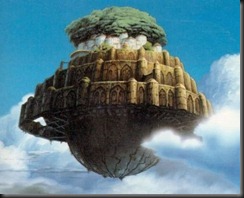 Cagliostro (1979), but Nausicaa remains the first film in his oeuvre to feature the distinctive Miyazaki style. After the success of Nausicaa, Miyazaki founded Studio Ghibli, which would release all of his subsequent films as well as films by others. Miyazaki followed up Nausicaa with Castle in the Sky (1986), a film that was loosely inspired by the third book of Jonathan Swift’s Gulliver’s Travels (1726)—the only real connection is that both works feature a floating city named Laputa. Castle in the Sky continues to develop the themes that he first set out in Nausicaa about humankind’s relation to the environment and to the things we create. Castle in the Sky is an action-packed tale of human greed and the wonder that drives innovation, but it is also a gentle and poignant tale about the creations we abandon and forget.
Cagliostro (1979), but Nausicaa remains the first film in his oeuvre to feature the distinctive Miyazaki style. After the success of Nausicaa, Miyazaki founded Studio Ghibli, which would release all of his subsequent films as well as films by others. Miyazaki followed up Nausicaa with Castle in the Sky (1986), a film that was loosely inspired by the third book of Jonathan Swift’s Gulliver’s Travels (1726)—the only real connection is that both works feature a floating city named Laputa. Castle in the Sky continues to develop the themes that he first set out in Nausicaa about humankind’s relation to the environment and to the things we create. Castle in the Sky is an action-packed tale of human greed and the wonder that drives innovation, but it is also a gentle and poignant tale about the creations we abandon and forget. 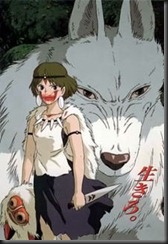 Miyazaki followed up the science fiction of Nausicaa and Castle in the Sky with a pair of films more distinctly aimed at children: My Neighbor Totoro (1988) and Kiki’s Delivery Service (1989). Then, Miyazaki achieved true critical acclaim with the release of Princess Mononoke in 1997. In many ways, Princess Mononoke feels like a retelling of Nausicaa, but Miyazaki had perfected his artistic style and further developed his storytelling abilities by this point. Instead of an apocalyptic setting, Princess Mononoke represents a work of magical realism set in the historical past of Japan. As with most of his films, Mononoke concerns the conflicts between the natural and civilized world and the conflict between spirituality and technological progress. An environmental parable about how humankind’s greed leads to not only the destruction of
Miyazaki followed up the science fiction of Nausicaa and Castle in the Sky with a pair of films more distinctly aimed at children: My Neighbor Totoro (1988) and Kiki’s Delivery Service (1989). Then, Miyazaki achieved true critical acclaim with the release of Princess Mononoke in 1997. In many ways, Princess Mononoke feels like a retelling of Nausicaa, but Miyazaki had perfected his artistic style and further developed his storytelling abilities by this point. Instead of an apocalyptic setting, Princess Mononoke represents a work of magical realism set in the historical past of Japan. As with most of his films, Mononoke concerns the conflicts between the natural and civilized world and the conflict between spirituality and technological progress. An environmental parable about how humankind’s greed leads to not only the destruction of 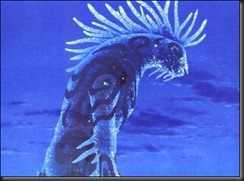 natural resources but the death of our beliefs. Indeed, as the corrupt humans seek the head of the benign forest spirit, the film seems to literalize Nietzsche’s statement that “God is dead, and we have killed him.” Technology is not always the enemy of spirituality—Castle in the Sky privileges a certain kind of technology that lives in harmony with nature. But, like Nausicaa and Spirited Away, to a lesser degree, Mononoke interrogates the complex relations between human reality and the spiritual world while simultaneously depicting the conflicts that arise with nature as technology progresses, populations grow, and resource demands increase. Set before the industrial revolution, Mononoke traces the beginnings of industrial greed and the original sins against the environment and suggests that we are perhaps still paying for these sins with our dependence upon fossil fuels, our smog-clouded skies, the extinction of species, etc., etc., etc. It is a poignant, beautiful, and action-packed fantasy that demonstrates the critical and aesthetic possibilities of anime. Princess Mononoke met with international critical acclaim as did Miyazaki’s next film, Spirited Away (2001), which fused the fantastic imagery of Nausicaa and Mononoke together with the children’s stories of Totoro and Kiki to create an unforgettable children’s film. And Miyazaki’s fame has continued to grow with subsequent releases like Howl’s Moving Castle (2004) and Ponyo (2008)—Ponyo represents Miyazaki’s version of Hans Christian Anderson’s “The Little Mermaid” (1837). His son has also released his first film, Tales from Earthsea (2006), based on the acclaimed series by American science fiction author Ursula K. Le Guin.
natural resources but the death of our beliefs. Indeed, as the corrupt humans seek the head of the benign forest spirit, the film seems to literalize Nietzsche’s statement that “God is dead, and we have killed him.” Technology is not always the enemy of spirituality—Castle in the Sky privileges a certain kind of technology that lives in harmony with nature. But, like Nausicaa and Spirited Away, to a lesser degree, Mononoke interrogates the complex relations between human reality and the spiritual world while simultaneously depicting the conflicts that arise with nature as technology progresses, populations grow, and resource demands increase. Set before the industrial revolution, Mononoke traces the beginnings of industrial greed and the original sins against the environment and suggests that we are perhaps still paying for these sins with our dependence upon fossil fuels, our smog-clouded skies, the extinction of species, etc., etc., etc. It is a poignant, beautiful, and action-packed fantasy that demonstrates the critical and aesthetic possibilities of anime. Princess Mononoke met with international critical acclaim as did Miyazaki’s next film, Spirited Away (2001), which fused the fantastic imagery of Nausicaa and Mononoke together with the children’s stories of Totoro and Kiki to create an unforgettable children’s film. And Miyazaki’s fame has continued to grow with subsequent releases like Howl’s Moving Castle (2004) and Ponyo (2008)—Ponyo represents Miyazaki’s version of Hans Christian Anderson’s “The Little Mermaid” (1837). His son has also released his first film, Tales from Earthsea (2006), based on the acclaimed series by American science fiction author Ursula K. Le Guin.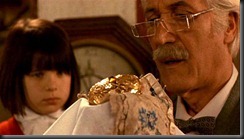 Distinctly darker than Miyazaki, Guillermo del Toro has directed a variety of both Spanish-language and Hollywood blockbuster films and has become one the most original directors of horror, science fiction, and fantasy over the last twenty years. Del Toro’s first major film was the Mexican horror film Cronos (1993), a bizarre take on vampire legends and humankind’s quest for immortality. A clockwork device containing a peculiar insect allows its user to become youthful again and live perpetually but with the need to consume blood. Stylish and bizarre, Cronos recalls the absurdist, black comedy sci-fi/fantasy films of Terry Gilliam (Brazil [1985], The Fisher King [1991], 12 Monkeys [1995], The Imaginarium of Dr. Parnassus [2009], etc.) and French filmmaker Jean-Pierre Jeunet who also burst on the international film scene in the early 1990s with his strange fusions of dark comedy and bizarro sci-fi like Delicatessen (1991) and The City of Lost Children (1995)—Jeunet would go on to direct the regrettable fourth Alien film, Alien: Resurrection (1997). Interestingly, Ron Perlman remains a recurring actor in both del Toro and Jeunet’s films.
Distinctly darker than Miyazaki, Guillermo del Toro has directed a variety of both Spanish-language and Hollywood blockbuster films and has become one the most original directors of horror, science fiction, and fantasy over the last twenty years. Del Toro’s first major film was the Mexican horror film Cronos (1993), a bizarre take on vampire legends and humankind’s quest for immortality. A clockwork device containing a peculiar insect allows its user to become youthful again and live perpetually but with the need to consume blood. Stylish and bizarre, Cronos recalls the absurdist, black comedy sci-fi/fantasy films of Terry Gilliam (Brazil [1985], The Fisher King [1991], 12 Monkeys [1995], The Imaginarium of Dr. Parnassus [2009], etc.) and French filmmaker Jean-Pierre Jeunet who also burst on the international film scene in the early 1990s with his strange fusions of dark comedy and bizarro sci-fi like Delicatessen (1991) and The City of Lost Children (1995)—Jeunet would go on to direct the regrettable fourth Alien film, Alien: Resurrection (1997). Interestingly, Ron Perlman remains a recurring actor in both del Toro and Jeunet’s films. 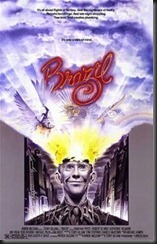
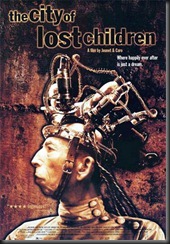
Like Miyazaki, I began watching Guillermo del Toro films without realizing it because he began to direct big-budget Hollywood films a few years after Cronos. His first Hollywood film was the at times stylish but ultimately forgettable Mimic (1997) which concerns a plague carried by cockroaches that is killing off the children of New York City. A scientist played by Mira Sorvino
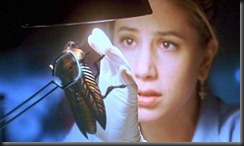 creates a special hybrid breed of insect that kills off the roaches but are designed to die off within a month, hence living the eco-system intact. Unfortunately, years later, people begin dying off in the sewers, and the scientists discover that the genetically engineered insects did not die off but instead adapted and began evolving in the sewers. Of course, loads of gross insect scenes and bloody deaths ensue. While Mimic is not a great film, it still exhibits del Toro’s fascination with bugs and his distinctively gothic filmic style.
creates a special hybrid breed of insect that kills off the roaches but are designed to die off within a month, hence living the eco-system intact. Unfortunately, years later, people begin dying off in the sewers, and the scientists discover that the genetically engineered insects did not die off but instead adapted and began evolving in the sewers. Of course, loads of gross insect scenes and bloody deaths ensue. While Mimic is not a great film, it still exhibits del Toro’s fascination with bugs and his distinctively gothic filmic style.Del Toro returned to
 Spanish-language cinema with his first masterpiece and the first entry in his proposed Spanish Civil War Trilogy: The Devil’s Backbone (2001). Shot in Madrid, the film concerns a young boy who comes to stay at an orphanage while his father is away fighting in the Spanish Civil War. In the courtyard near the orphanage, an unexploded Fascist bomb stands wedged in the ground, and the ghost of a young boy haunts the orphanage. With The Devil’s Backbone, del Toro firmly established his own unique gothic blend of fantasy and horror and demonstrated his ability to use fantastic genres as a means of interrogating socio-political and historical issues. A tale of greed, cruelty, love, and war,
Spanish-language cinema with his first masterpiece and the first entry in his proposed Spanish Civil War Trilogy: The Devil’s Backbone (2001). Shot in Madrid, the film concerns a young boy who comes to stay at an orphanage while his father is away fighting in the Spanish Civil War. In the courtyard near the orphanage, an unexploded Fascist bomb stands wedged in the ground, and the ghost of a young boy haunts the orphanage. With The Devil’s Backbone, del Toro firmly established his own unique gothic blend of fantasy and horror and demonstrated his ability to use fantastic genres as a means of interrogating socio-political and historical issues. A tale of greed, cruelty, love, and war, 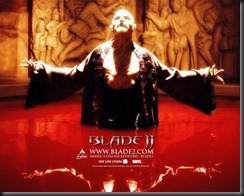 The Devil’s Backbone, like Pan’s Labyrinth, uses a child’s experience of the horrific and the fantastic to examine the nature of war and its effects upon the populace, particularly civil war in which people turn against and slaughter one another.
The Devil’s Backbone, like Pan’s Labyrinth, uses a child’s experience of the horrific and the fantastic to examine the nature of war and its effects upon the populace, particularly civil war in which people turn against and slaughter one another.Del Toro then went on to create two more commercial films for Hollywood based on comic book characters. First, he helmed the second entry in the Blade series. In my opinion the best of the three Blade films, Blade II blends action, gore, and monstrosities together with del Toro’s signature style to create a genuinely stylish mass market film. While Blade II is not overly impressive except in comparison with other comic and vampire films, his next Hollywood film would demonstrate his ability to direct mass market
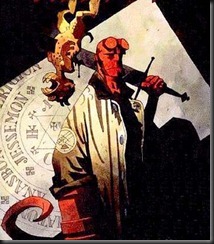 films without sacrificing creativity and style. Based on Mike Mignola’s cult classic comic series from Dark Horse Comics, del Toro’s Hellboy maintained Mignola’s unique blend of black comedy and Lovecraftian horror while adding his own unique cinematic style to the film. Hellboy blended action, comedy, horror, romance, and fantastic visuals together into a sci-fi/horror experience like few others. In case you are unfamiliar with the premise, Hellboy concerns a paranormal investigator who is actually a demon. During WWII, Nazi occult researchers attempted to summon demons to help the Reich win the war, but American forces arrived and stopped them during the
films without sacrificing creativity and style. Based on Mike Mignola’s cult classic comic series from Dark Horse Comics, del Toro’s Hellboy maintained Mignola’s unique blend of black comedy and Lovecraftian horror while adding his own unique cinematic style to the film. Hellboy blended action, comedy, horror, romance, and fantastic visuals together into a sci-fi/horror experience like few others. In case you are unfamiliar with the premise, Hellboy concerns a paranormal investigator who is actually a demon. During WWII, Nazi occult researchers attempted to summon demons to help the Reich win the war, but American forces arrived and stopped them during the 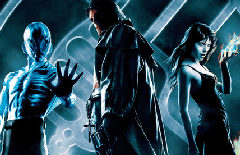 process. However, the demon still came across from the nether regions but ended up being nothing more than a demon baby. Raised by an American scientist, Hellboy grew up to be the primary agents of the Bureau for Paranormal Research and Defense, a covert government agency that tackles any incidents dealing with monsters, ghosts, demons, or other paranormal phenomena. Del Toro created follow-ups to both The Devil’s Backbone and Hellboy. Pan’s Labyrinth represented the second part of his Spanish Civil War Trilogy, and it was met with critical acclaim upon its release. Hellboy II: The Golden Army brought in the fantasy elements present in Pan’s Labyrinth and merged them with the gothic, horror elements of the franchise. Hellboy II debuted with even more acclaim than its predecessor. Guillermo del Toro has effectively established himself as a significant force in the genre of fantastic cinema, and he is already attached to film adaptations of numerous classic works of fantastic literature: Mary Shelley’s Frankenstein, J.R.R. Tolkien’s The Hobbit, and H.P. Lovecraft’s At the Mountains of Madness will all purportedly be directed by del Toro.
process. However, the demon still came across from the nether regions but ended up being nothing more than a demon baby. Raised by an American scientist, Hellboy grew up to be the primary agents of the Bureau for Paranormal Research and Defense, a covert government agency that tackles any incidents dealing with monsters, ghosts, demons, or other paranormal phenomena. Del Toro created follow-ups to both The Devil’s Backbone and Hellboy. Pan’s Labyrinth represented the second part of his Spanish Civil War Trilogy, and it was met with critical acclaim upon its release. Hellboy II: The Golden Army brought in the fantasy elements present in Pan’s Labyrinth and merged them with the gothic, horror elements of the franchise. Hellboy II debuted with even more acclaim than its predecessor. Guillermo del Toro has effectively established himself as a significant force in the genre of fantastic cinema, and he is already attached to film adaptations of numerous classic works of fantastic literature: Mary Shelley’s Frankenstein, J.R.R. Tolkien’s The Hobbit, and H.P. Lovecraft’s At the Mountains of Madness will all purportedly be directed by del Toro.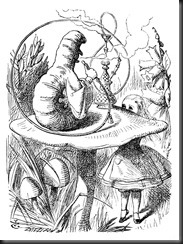 Both Miyazaki and del Toro have the uncanny ability to delve into the fears and wonder of childhood—they evoke both the dreams and the nightmares of children and use fantasy to explore how the childish psyche processes the various experiences and traumas it must endure on its passage into adulthood. They follow in a long tradition of children’s literature that includes such classic works as Lewis Carroll’s Alice’s Adventures in Wonderland (1865), L. Frank Baum’s The Wonderful Wizard of Oz (1900), J.M. Barrie’s Peter Pan (1904), A.A. Milne’s Winnie-the-Pooh (1926), etc. If you enjoyed Pan’s Labyrinth and Spirited Away, then I highly recommend that you check out del Toro and Miyazaki’s other films. And if you are a big fan of weird cinema, then definitely try watching Terry Gilliam and Jean-Pierre Jeunet. Gilliam recently released his own
Both Miyazaki and del Toro have the uncanny ability to delve into the fears and wonder of childhood—they evoke both the dreams and the nightmares of children and use fantasy to explore how the childish psyche processes the various experiences and traumas it must endure on its passage into adulthood. They follow in a long tradition of children’s literature that includes such classic works as Lewis Carroll’s Alice’s Adventures in Wonderland (1865), L. Frank Baum’s The Wonderful Wizard of Oz (1900), J.M. Barrie’s Peter Pan (1904), A.A. Milne’s Winnie-the-Pooh (1926), etc. If you enjoyed Pan’s Labyrinth and Spirited Away, then I highly recommend that you check out del Toro and Miyazaki’s other films. And if you are a big fan of weird cinema, then definitely try watching Terry Gilliam and Jean-Pierre Jeunet. Gilliam recently released his own 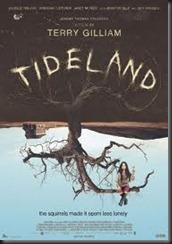 Alice-in-Wonderland-style film entitled Tideland (2005), which was rather scandalous for its depiction of the ten-year-old (or so) female protagonist helping her father (played by Jeff Bridges) cook up and then shoot up heroin. She moves to a country house with her drug-addict father and soon develops a relationship with the mentally handicapped man next door and his recluse sister. Slowly, she begins to create fantastic worlds that she and her new friends inhabit, and the lines between reality and fantasy begin to blur. Tideland is hard to watch and rather disturbing, but it does represent a unique contribution to the genre of dark childhood fantasies similar to Spirited Away and Pan’s Labyrinth.
Alice-in-Wonderland-style film entitled Tideland (2005), which was rather scandalous for its depiction of the ten-year-old (or so) female protagonist helping her father (played by Jeff Bridges) cook up and then shoot up heroin. She moves to a country house with her drug-addict father and soon develops a relationship with the mentally handicapped man next door and his recluse sister. Slowly, she begins to create fantastic worlds that she and her new friends inhabit, and the lines between reality and fantasy begin to blur. Tideland is hard to watch and rather disturbing, but it does represent a unique contribution to the genre of dark childhood fantasies similar to Spirited Away and Pan’s Labyrinth.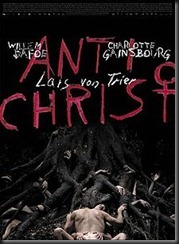 All of these films that focus on childhood only serve to remind me that children are not the only ones who retreat into fantasy when they experience traumatic events. Adults too can reach points in their lives where the lines between reality and dream/fantasy begin to blur and merge into one another. Of late, one particular film springs to mind that examines how adults use fantasy to inscribe meaning upon the seemingly meaningless and cruel events of their lives: Lars von Trier’s Antichrist (2009). Von Trier became famous as the frontman of the Dogme 95 movement, which featured a series of vows that the filmmaker must swear to in order to have his work certified as a Dogme 95
All of these films that focus on childhood only serve to remind me that children are not the only ones who retreat into fantasy when they experience traumatic events. Adults too can reach points in their lives where the lines between reality and dream/fantasy begin to blur and merge into one another. Of late, one particular film springs to mind that examines how adults use fantasy to inscribe meaning upon the seemingly meaningless and cruel events of their lives: Lars von Trier’s Antichrist (2009). Von Trier became famous as the frontman of the Dogme 95 movement, which featured a series of vows that the filmmaker must swear to in order to have his work certified as a Dogme 95 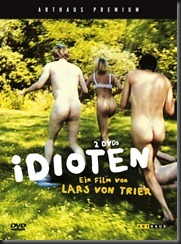 film. The filmmaker also had to confess any “sins” that s/he had committed in making the film. Dogme 95 privileged shooting on location, using no outside props, using natural lighting, etc. While he is associated with the movement, von Trier only created one Dogme 95 certified film, The Idiots (1998). Von Trier’s films always feature controversial subject matter, graphic and even unsimulated sex scenes, and often shockingly minimalistic aesthetics. With Antichrist, von Trier firmly breaks away from the Dogme 95 group and embraces special effects to create one of the most visceral and disturbing films of the last decade. Antichrist shocked audiences at the Cannes Film Festival some of whom supposedly suffered convulsions. The film concerns a couple whose son falls out a window and dies while they are making love in the shower. Aside from the first brief scenes with the son, the film only features the couple, played by Willem Dafoe and Charlotte Gainsbourg. Devastated by the tragedy, the wife has become dependent on a heavy regime of anti-depressants and other drugs. Her husband decides that she must not mask her pain with drugs but instead face her grief and consequently resolve it. The two retreat to their cabin deep in the woods where the bulk of the film unfolds as a Freudian nightmare with tinges of the fantastic. The couple, particularly the wife, begin to lose their grip on reality in the isolated cabin, which is flooded with memories of their
film. The filmmaker also had to confess any “sins” that s/he had committed in making the film. Dogme 95 privileged shooting on location, using no outside props, using natural lighting, etc. While he is associated with the movement, von Trier only created one Dogme 95 certified film, The Idiots (1998). Von Trier’s films always feature controversial subject matter, graphic and even unsimulated sex scenes, and often shockingly minimalistic aesthetics. With Antichrist, von Trier firmly breaks away from the Dogme 95 group and embraces special effects to create one of the most visceral and disturbing films of the last decade. Antichrist shocked audiences at the Cannes Film Festival some of whom supposedly suffered convulsions. The film concerns a couple whose son falls out a window and dies while they are making love in the shower. Aside from the first brief scenes with the son, the film only features the couple, played by Willem Dafoe and Charlotte Gainsbourg. Devastated by the tragedy, the wife has become dependent on a heavy regime of anti-depressants and other drugs. Her husband decides that she must not mask her pain with drugs but instead face her grief and consequently resolve it. The two retreat to their cabin deep in the woods where the bulk of the film unfolds as a Freudian nightmare with tinges of the fantastic. The couple, particularly the wife, begin to lose their grip on reality in the isolated cabin, which is flooded with memories of their  son. Featuring unsimulated, explicit sex thanks to so-called “porn doubles,” graphic genital mutilation, and bizarre moments of the fantastic including a talking fox, Antichrist is a powerful meditation upon grief and psychological disorders. Von Trier’s films often feature female protagonists, but he is often labeled as misogynistic, an adjective that was also applied to Antichrist. But, for me, the film actually has a feminist message about the inherent dangers of male authority and the oppression of women. Von Trier’s films are almost always controversial for their subject matter and graphic content, but they often blend elements of the fantastic with stark realism to create uncompromisingly powerful films that explore how our fantasies shape our perceptions of reality. For example, Dancer in the Dark (2000) concerns a woman (played by Bjork) whose fascination with musicals slowly begins to influence her life even up to the point where she is hanged for murder she never intended to commit. Along the way, we see the imaginary musical numbers that allow her to cope with the reality of her situation.
son. Featuring unsimulated, explicit sex thanks to so-called “porn doubles,” graphic genital mutilation, and bizarre moments of the fantastic including a talking fox, Antichrist is a powerful meditation upon grief and psychological disorders. Von Trier’s films often feature female protagonists, but he is often labeled as misogynistic, an adjective that was also applied to Antichrist. But, for me, the film actually has a feminist message about the inherent dangers of male authority and the oppression of women. Von Trier’s films are almost always controversial for their subject matter and graphic content, but they often blend elements of the fantastic with stark realism to create uncompromisingly powerful films that explore how our fantasies shape our perceptions of reality. For example, Dancer in the Dark (2000) concerns a woman (played by Bjork) whose fascination with musicals slowly begins to influence her life even up to the point where she is hanged for murder she never intended to commit. Along the way, we see the imaginary musical numbers that allow her to cope with the reality of her situation.
